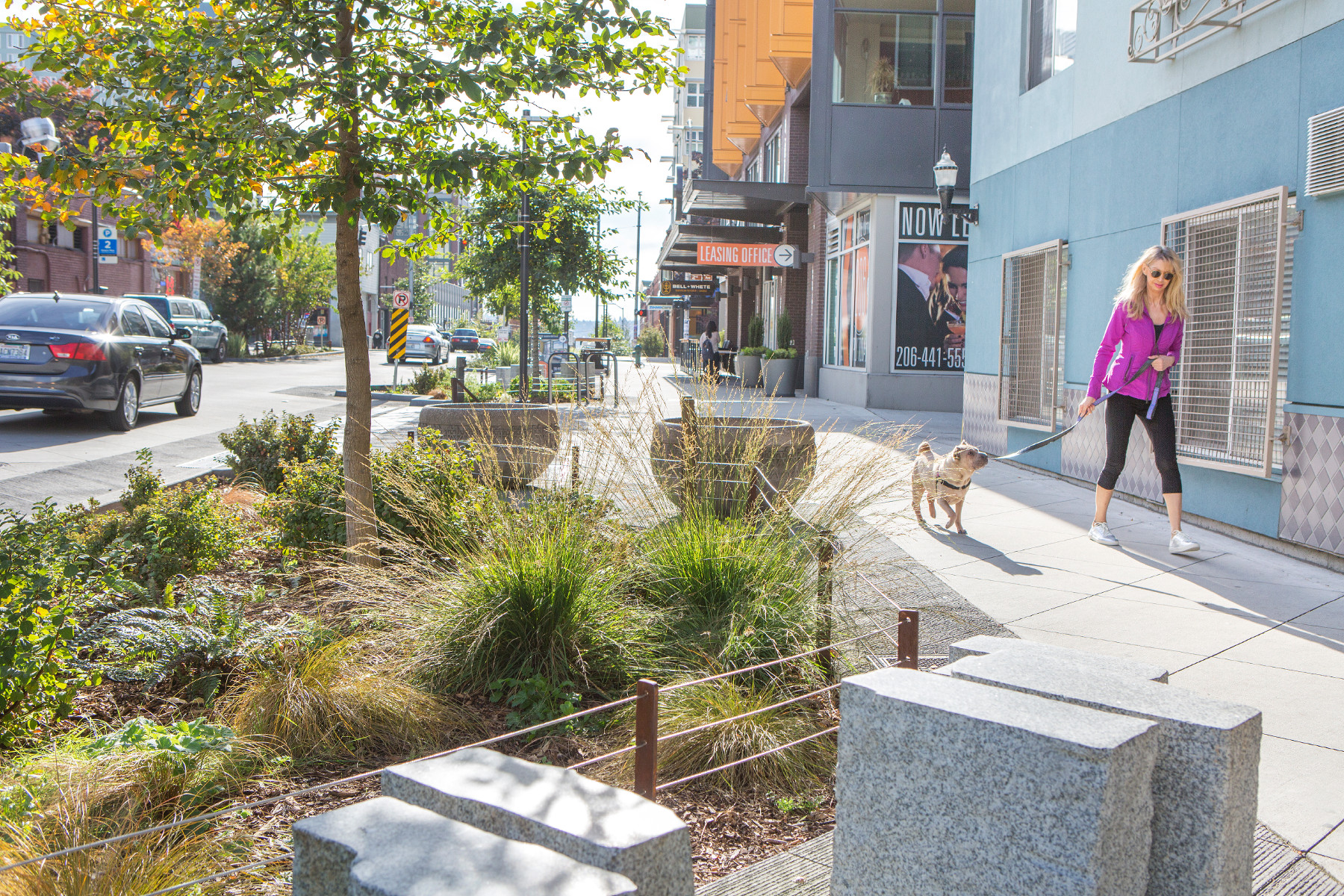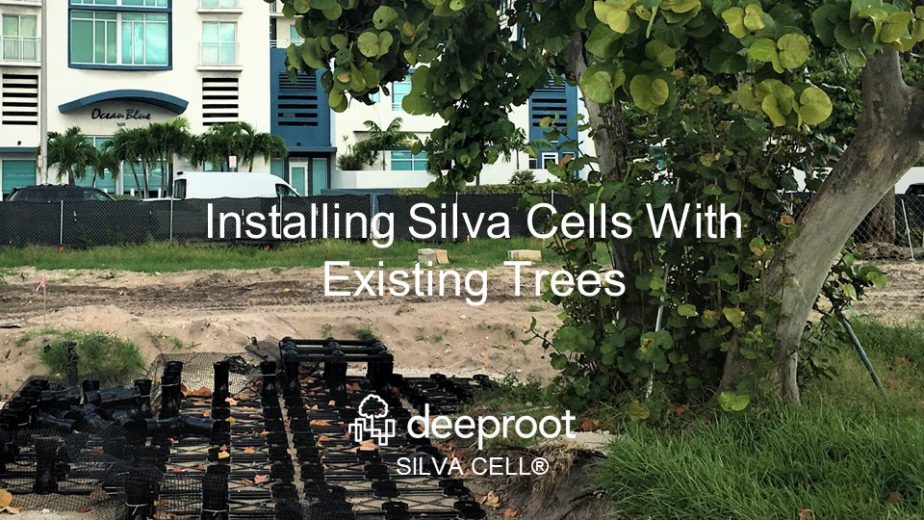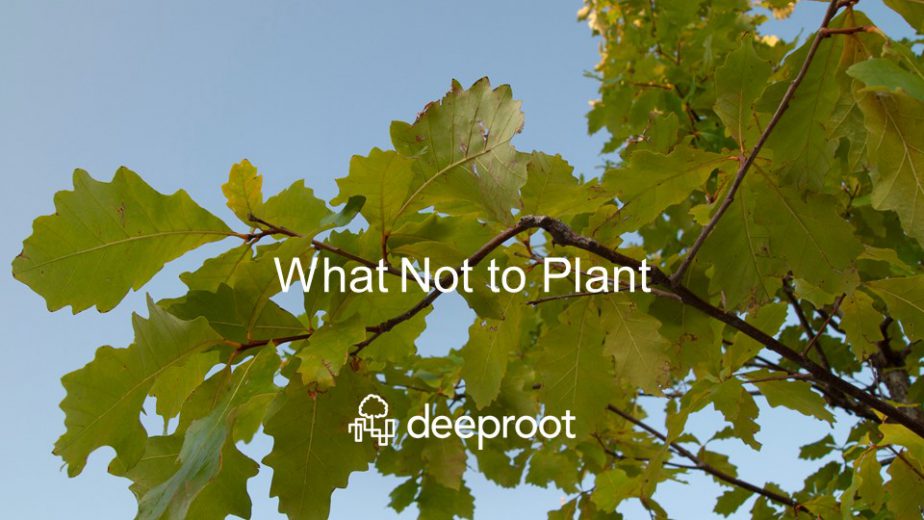Have you ever had someone step on your foot? It hurts, right? Your foot has lots of little bones that are sensitive just like a tree has roots. Cities are considering ways to protect those tree roots and allow space for seasonal plantings that add vibrancy to downtown and mixed-use areas. There are a variety of products and methods that have been tried over time to protect the health of urban trees and plantings. Design and product selection is a delicate balance of trying to meet the needs of competing urban infrastructure and people walking and biking with soil health for trees to thrive in this far-from-natural environment.
Our thinking as designers of environments that must work for both nature and people has come a long way: we recognize the incredible value provided by the urban canopy, but have to always be mindful of keeping city sidewalks flexible, inclusive, and inviting for human use. Tree grates, one such product intended to protect trees from harsh urban environments, run a high risk of doing significant damage, both from the grate’s opening girdling the trunk and from the often-tight concrete or metal collars that the grates typically sit on that are restrictive to the trunk flare and roots below. Tree fences, which protect entire rooting areas from urban traffic, are one option that cities have been testing out.
What is a tree fence?
Tree fences have been used in various ways and can mean different things to landscape architects, city planners, engineers and street maintenance staff, so for this article, I’m defining them as the low (2 feet or less), fixed fences surrounding trees and often plantings on three sides in urban planting strip areas. It not meant to describe those tall (often over 4 feet), metal fences with spikes at the top that act as collars to tree trunks. The fences I would like to focus on can be made of a variety of materials, but their primary goal is to provide protection to trees and plantings from pedestrians walking alongside the trunks and over their roots.
Benefits
The most beneficial aspect to using tree fences is that they minimize the compaction of surface soils which allows the rain to penetrate and become available to tree roots (see James Urban’s many articles on this topic). Limiting compaction is important not only for trees but also for stormwater runoff. For any urban planting area or vegetated stormwater facility, soil compaction can make the difference between a functioning system and a non-functioning one.
Tree fences provide a buffer between vehicular traffic and the pedestrian zone and the street trees themselves increase safety (Safe Streets, Livable Streets, Eric Dumbaugh, Journal of the American Planning Association, Vol 71, No 3, Summer 2005). Protecting urban street trees for all their many benefits should be an inherent strategy to all designers, engineers and city planners.
Smaller vegetation needs protection from being trampled by people, carts, luggage and the many other “urban predators” of plants. Bolstering understory planting areas can beautify the urban realm and help mitigate stormwater runoff, particularly if they are designed in long planters rather than the size of a modest tree pit.
There is a perception that the tree fences deter dogs from running through plantings and peeing, though there is not enough research to support this strategy as being successful. I have witnessed large dogs stepping over them or peeing through them and smaller dogs being lifted over the fences and placed in the planting areas, regardless of “no dogs” signs being posted. With limited vegetated areas in urban areas, thinking that you can design away dogs seems unrealistic and unsupportive to pedestrian needs.
Tree fences that are similar in material, color and style offer a sense of consistency along a streetscape and bringing a sense of identity and character to business districts and neighborhoods.
Limitations and considerations
When thinking about the balance between the needs of trees and people in a city, be aware that low fences can pose a tripping hazard or a barrier if their location narrows down an already tight horizontal sidewalk zone (they should not be utilized if the sidewalk zone is less than 6 feet). Because they are fixed objects, they do not leave flexibility for those needing more space such as large crowds in shopping districts or at stadium events, people pushing carts, operating large maintenance vehicles or other machinery, or those needing to move around in a mobility device like a scooter or wheelchair.
When working with cities to develop design standards, the benefits of the tree fence are clear, but there are limitations relative to materiality and context.
Sidewalk slopes can be so steep that the fence racking – which is the amount of “flex” that the horizontal rails of the fence have with the vertical posts at install before they are fixed in place on site – cannot make up for to allow the fence to stand upright while the rails run along the slope. It is good practice to work with a manufacturer to detail fencing to fit with steeper sidewalks or stepped conditions.
Custom fencing creates special zones but can be a maintenance issue for repairs and replacement. Maintenance is a realistic constraint when choosing materials within public right of ways and tree fencing material and area should be selected, sized, and located with this in mind. How will the materials hold up to weather, can they be recoated, are the surfaces attractive to graffiti?
Retrofitting fences raises additional issues as the installation approach need to consider the location of major roots and choosing an approach that minimizes excavation. This leads into the question of ownership and responsibility. Who maintains them? The City or adjacent property owner? Does the City agency want to control consistency in the fences’ materiality, height, style, and color or the speed of replacement?
Cities using tree fences
Several cities are actively pursuing tree fences with different approaches.
Seattle, for instance, is considering incorporating them into their Downtown Design Standards. New York City has utilized tree fences for decades and now NYC Parks is working with a group called Trees New York, labeling their fences “tree guards” and including information for owners to independently install a fence in the right of way by contacting a list of manufacturers. Recently, NYC Parks adopted “tree guards” into their Tree Planting Standards, with an appendix of approved designs and specifications for how they should be installed and maintained. Washington D.C. has utilized tree fences for peak flows of visitors and frequent parades. The DC Department of Transportation also has gone as far as having detailed tree fence specifications and installation instructions that include the dimension of the step out zone at the curb to account for parked vehicle doors opening and people getting out of them.
Conclusion
As we improve the use of vegetation for people and habitat in our higher use areas, designers should weigh the pros and cons to tree fences, their style, and location. A designer should consult with the city agency for guidance along streets and with property maintenance staff in the use of tree fences in plazas. Protecting the urban canopy is an evolving process with evolving tools. Often, the best solution will consist of multiple products and methods that address the complexity of conditions over time.
Amanda is a landscape architect with eight years of experience working in a wide range of streetscape design, parks and planning projects. Her passion is designing thoughtful and innovative user experiences which provide layers of benefits to population and environmental health and sustainability.
Top image credit MIG | SvR.





Greeting,
I live down southeast asia, i’ve seen parts of the beautiful places, forests reserve land and the like. I ask permission to repost from your site and send it to our local elect executives so that they be enlightened or be aware of protecting and caring of what’s left. In our ecosystem.
Thank you .
eric
Eric: thank you for your comment, and yes please feel free to share this post!